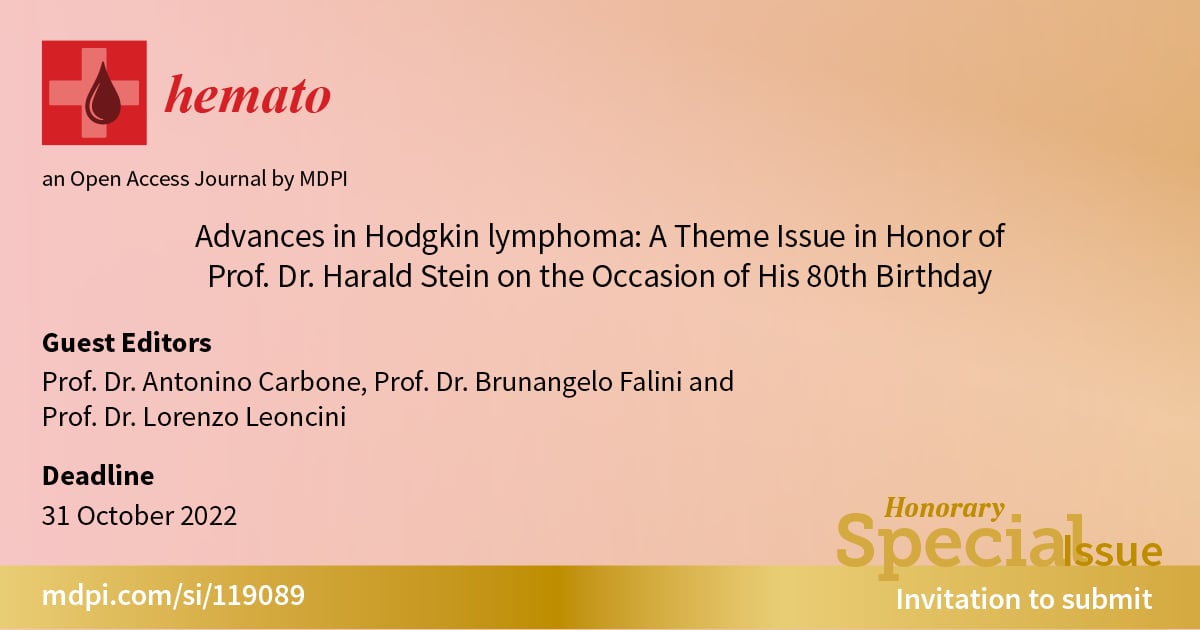- 1.0Impact Factor
- 2.0CiteScore
- 34 daysTime to First Decision
Advances in Hodgkin lymphoma: A Theme Issue in Honor of Prof. Dr. Harald Stein
This special issue belongs to the section “Lymphomas“.
Special Issue Information
Dear Colleagues,
We are preparing a Special Issue in honor of Prof. Harald Stein because of his important contribution to the modern classification of lymphomas.
When Harald Stein was employed in Karl Lennert’s Institute in 1968, he was exposed to Lennert’s classification. Stein could not understand the doctrine of the classification that large cell neoplasms of lymph nodes are derived from reticulum cells. This doctrine was based on morphology alone. Nobody at the time knew what reticulum cells were, and the reproducibility of the diagnosis was low. Therefore, Stein decided to search for molecular markers. In 1970, Stein read the Nature publication by Martin Raff in which Raff reported that B cells carry IgM on their surface. Stein then analyzed reticulum sarcomas for IgM with the radial immunodiffusion technique. The majority of these tumors were IgM positive, and thus, proved to be B-cell lymphomas (Stein et al. Lancet 2002). However, it took Stein 9 years to solve the classification of IgM-negative large cell tumors. Stein and his team of Johannes Gerdes and Hilmar Lemke succeeded in 1981 when they discovered—by using the L428 cell line—the Ki-1 molecule; in 1986, this was included in the CD classification as CD30. The IgM-negative large cell tumors proved to be Ki-1/CD30 positive and were first called Ki-1 lymphomas; they were finally designated, on Stein’s proposal, as anaplastic large cell lymphomas (ALCL). For the worldwide application of CD30 for diagnostic purposes, Stein generated with another team the monoclonal antibody Ber-H2 which functions on FFPE tissue sections (1989). The usage of Ber-H2 (Ber for Berlin) confirmed the constant expression of CD30 by HRS cells of classical Hodgkin lymphoma (CHL) and its constant absence in lymphocyte-predominant Hodgkin lymphoma (NLPHL). The application of the Ber-H2 antibody was further revealed by the large European Task Force on Lymphoma project to be a new subtype of CHL: nodular lymphocyte-rich classical Hodgkin lymphoma (NLRCHL), which was frequently misdiagnosed as NLPHL. Stein also discovered with Johannes Gerdes and Hilmar Lemke the Ki-67 molecule as a marker for cell proliferation, which was published in 1983.
In cooperation with David Mason, Stein generated monoclonal antibodies specific for B cells (clustered as CD22) and follicular dendritic cells (clustered das CD21).
In 1991, Stein and Peter Isaacson founded the “International Lymphoma Study Group (ILSG)” by bringing together 19 internationally known experts in hematopathology with the aim of establishing a biologically correct lymphoma classification valid on both sides of the Atlantic. In 1994, the ILSG proposed the REAL classification of lymphomas, which was subsequently taken over by the WHO classification. Stein worked as a co-editor for the WHO’s lymphoma projects until 2017.
Prof. Dr. Antonino Carbone
Prof. Dr. Brunangelo Falini
Prof. Dr. Lorenzo Leoncini
Guest Editors
Manuscript Submission Information
Manuscripts should be submitted online at www.mdpi.com by registering and logging in to this website. Once you are registered, click here to go to the submission form. Manuscripts can be submitted until the deadline. All submissions that pass pre-check are peer-reviewed. Accepted papers will be published continuously in the journal (as soon as accepted) and will be listed together on the special issue website. Research articles, review articles as well as short communications are invited. For planned papers, a title and short abstract (about 250 words) can be sent to the Editorial Office for assessment.
Submitted manuscripts should not have been published previously, nor be under consideration for publication elsewhere (except conference proceedings papers). All manuscripts are thoroughly refereed through a single-blind peer-review process. A guide for authors and other relevant information for submission of manuscripts is available on the Instructions for Authors page. Hemato is an international peer-reviewed open access quarterly journal published by MDPI.
Please visit the Instructions for Authors page before submitting a manuscript. The Article Processing Charge (APC) for publication in this open access journal is 1200 CHF (Swiss Francs). Submitted papers should be well formatted and use good English. Authors may use MDPI's English editing service prior to publication or during author revisions.
Keywords
- Hodgkin lymphoma

Benefits of Publishing in a Special Issue
- Ease of navigation: Grouping papers by topic helps scholars navigate broad scope journals more efficiently.
- Greater discoverability: Special Issues support the reach and impact of scientific research. Articles in Special Issues are more discoverable and cited more frequently.
- Expansion of research network: Special Issues facilitate connections among authors, fostering scientific collaborations.
- External promotion: Articles in Special Issues are often promoted through the journal's social media, increasing their visibility.
- e-Book format: Special Issues with more than 10 articles can be published as dedicated e-books, ensuring wide and rapid dissemination.

